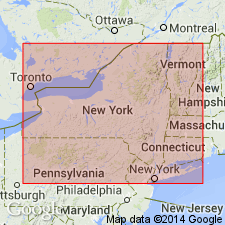
- Usage in publication:
-
- Onondaga limestone
- Modifications:
-
- Named
- Dominant lithology:
-
- Limestone
- AAPG geologic province:
-
- Appalachian basin
Summary:
Named the Onondaga limestone in PA, NY, western MD, VA, and WV for Onondaga Co., PA. Also called gray crinoidal limestone. Consists of gray or grayish-blue compact crystalline limestone. Overlies the Oriskany sandstone and underlies the Seneca limestone. The Onondaga is of Middle Devonian age.
Source: GNU records (USGS DDS-6; Reston GNULEX).
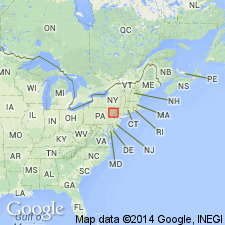
- Usage in publication:
-
- Onondaga group
- Modifications:
-
- Revised
- AAPG geologic province:
-
- Appalachian basin
Summary:
Raised the Onondaga to the Onondaga group in PA. Group includes all stratigraphic units between top of preceding Oriskany group and succeeding Marcellus formation of Hamilton group. In central PA the Onondaga group consists of (ascending) the Needmore shale and Selinsgrove limestone; in eastern PA consists of the Esopus shale and Buttermilk Falls limestone.
Source: GNU records (USGS DDS-6; Reston GNULEX).
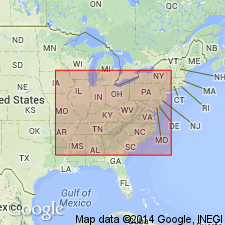
- Usage in publication:
-
- Onondaga Limestone
- Modifications:
-
- Areal extent
- AAPG geologic province:
-
- Appalachian basin
Summary:
Geographically extended the Onondaga Limestone to northwestern NJ. Consists of dark gray cherty limestone and shale. Thickness is about 200 ft. Overlies the Esopus Grit.
Source: GNU records (USGS DDS-6; Reston GNULEX).

- Usage in publication:
-
- Onondaga Limestone
- Modifications:
-
- Revised
- AAPG geologic province:
-
- Appalachian basin
Summary:
Three bentonites are herein named in the Moorehouse Member of the Onondaga Limestone: the First Cheektowaga Bentonite, the Second Cheektowaga Bentonite, and the Onondaga Indian Nation Bentonite. The last has been frequently mistaken for the Tioga, which is at the base of the Marcellus Shale, much higher in the section. The Seneca-Moorehouse Member boundary is also revised. Boundary has been placed until now at the occurrence of Hall's (1939) bentonite bed (here called the Onondaga Indian Nation Bentonite), but it is actually 1.9 to 4.1 ft above this marker bed.
Source: GNU records (USGS DDS-6; Reston GNULEX).
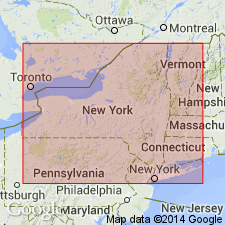
- Usage in publication:
-
- Onondaga Limestone
- Modifications:
-
- Revised
- AAPG geologic province:
-
- Appalachian basin
Summary:
Middle Devonian Onondaga of NY represents broad, carbonate platform facies deposited during early to middle Eifelian time. Carbonates are characterized by calcarenitic to cherty to argillaceous limestones and minor shales deposited in a shallow epicontinental sea. The Selinsgrove Limestone Member of the Needmore Formation of central PA is the direct equivalent of the Onondaga Limestone in NY. The Onondaga is generally subdivided into four members across NY: Edgecliff, Nedrow, Moorehouse, and Seneca. These four members are directly equivalent to those of the Buttermilk Falls Limestone of eastern PA. The Clarence Member has been recognized only in western NY and is here designated a local informal facies of the Edgecliff. The informal Jamesville Quarry facies of the Edgecliff is also named in this report for the chert-poor, crinoidal pack- and grainstone that occurs at the Edgecliff type locality. Several marker beds within the Nedrow Member are recognized and the upper boundary with the Moorehouse Member is redefined. The Moorehouse contains several fossil horizons and the Seneca contains several bentonite beds, including the Tioga B or Onondaga Indian Nation Bentonite, which defines its base. The Lower-Middle Devonian (Emsian-Eifelian) boundary, long placed at the base of the Onondaga in NY, could lie as high as the base of the Nedrow Member according to Kirchgasser and Oliver (1993), as there are no age diagnostic fossils in the Edgecliff.
Source: GNU records (USGS DDS-6; Reston GNULEX).
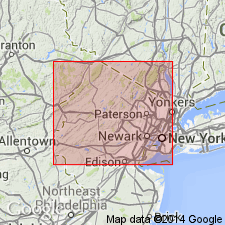
- Usage in publication:
-
- Onondaga Limestone*
- Modifications:
-
- Overview
- AAPG geologic province:
-
- Appalachian basin
Summary:
The Onondaga Limestone in northern NJ is mapped along with the Buttermilk Falls Limestone. The Onondaga consists of light-gray weathering, medium-gray, fine-grained, thin- to medium-bedded, fossiliferous limestone with black chert. Black chert is more abundant in upper part. Thickness is 60 m. Grades into the Buttermilk Falls Limestone to the southwest. Overlies the Schoharie Formation and underlies the Marcellus Shale. The Onondaga is of Middle Devonian age.
Source: GNU records (USGS DDS-6; Reston GNULEX).
For more information, please contact Nancy Stamm, Geologic Names Committee Secretary.
Asterisk (*) indicates published by U.S. Geological Survey authors.
"No current usage" (†) implies that a name has been abandoned or has fallen into disuse. Former usage and, if known, replacement name given in parentheses ( ).
Slash (/) indicates name conflicts with nomenclatural guidelines (CSN, 1933; ACSN, 1961, 1970; NACSN, 1983, 2005, 2021). May be explained within brackets ([ ]).

